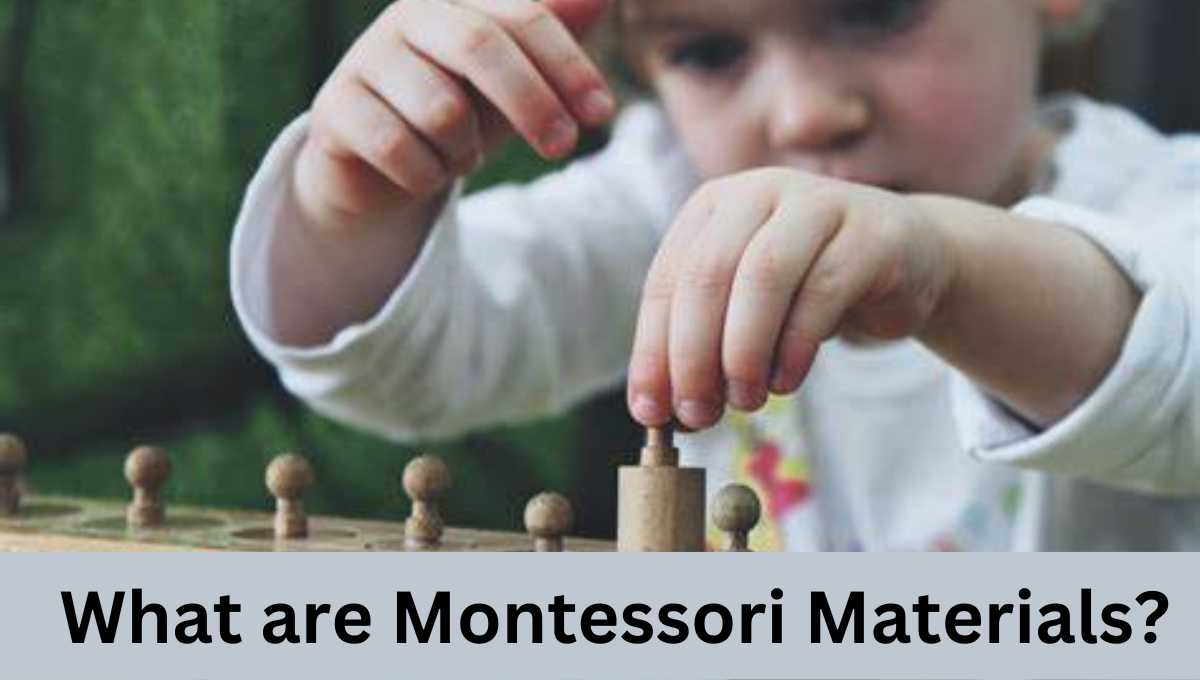Why Montessori Materials Are Essential?
Montessori materials are educational tools specifically designed to facilitate hands-on, experiential learning in a Montessori classroom. The materials are carefully crafted to promote independent learning, self-discovery, and the development of various skills in children.
Key Characteristics of Montessori Materials
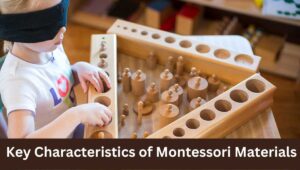
Montessori materials are special tools and activities designed to help kids learn in a hands-on way.
Made for a Reason
- Montessori materials are created on purpose to help children learn different things. Each material is like a special tool that teaches a specific skill.
Hands-On and Touchable
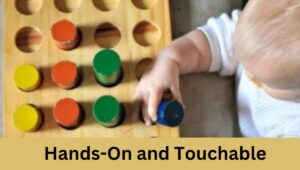
- These materials are things that kids can touch and move around. They are not just pictures or words in a book; they are real things that children can play with and explore.
Fix Mistakes by Yourself
- Imagine if you were playing a game, and you made a mistake, but you could figure out how to fix it without anyone telling you. Montessori materials are like that – they help kids see and fix their own mistakes.
Start Easy and Get a Bit Harder
- The materials are arranged from easy to a little bit hard. It’s like playing a video game where you start with simple levels and gradually go to more challenging ones. This helps kids learn step by step.
Show When You’re Right or Wrong
- If a child does something right or wrong, the materials make it clear without needing a teacher to say so. It’s like having hints or clues in a game that help you know how well you’re doing.
Move from Simple to a Bit Complicated
- Just like when you learn to ride a bike with training wheels first, Montessori materials help kids start with simple activities and move on to more complicated ones when they’re ready.
Choose What You Like
- Kids in Montessori classrooms can decide which activities they want to do. The materials are set up so that children can choose what interests them and learn at their own speed.
These special tools and activities in a Montessori classroom are like having fun toys that also teach important things. They make learning interesting and allow kids to discover new things on their own.
Examples of Montessori Materials
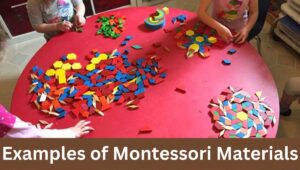
Number Rods
- What it is: Long wooden rods of different lengths, each painted a different color.
- How it helps: Children use these rods to understand the concept of numbers and quantities. It’s like learning to count using colorful sticks.
Pink Tower
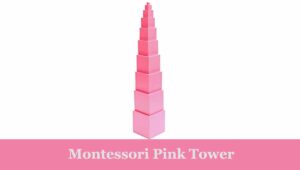
- What it is: Montessori Pink Tower: A set of pink wooden cubes of different sizes, arranged from the biggest to the smallest.
- How it helps: Kids use this tower to develop their sense of size and spatial awareness. It’s like building with blocks but in a special order.
Golden Beads
- What it is: Small, golden-colored beads organized into units, tens, hundreds, and thousands.
- How it helps: Children use these beads to learn about the decimal system and basic math. It’s like playing with shiny beads while learning big numbers.
Practical Life Pouring Activities
- What it is: Small pitchers and containers for pouring liquids.
- How it helps: Kids practice pouring to develop coordination and independence. It’s like pouring your own drink at home.
Moveable Alphabet
- What it is: A set of letters that can be moved and arranged to create words.
- How it helps: Children use these letters to explore and experiment with making words. It’s like having a box of letters to play with and make your own stories.
Botany Materials
- What it is: Tools and materials for exploring plants, seeds, and gardening.
- How it helps: Kids learn about the natural world, from planting seeds to watching plants grow. It’s like having your own little garden to take care of.
Color Tablets
- What it is: Sets of tablets in different colors.
- How it helps: Children use these tablets to refine their ability to see and distinguish between colors. It’s like playing with colorful cards to become a color expert.
Sandpaper Letters
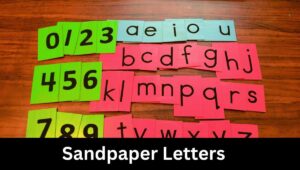
- What it is: Wooden or cardboard letters with a rough, sandpaper-like surface.
- How it helps: Kids can feel the shape of each letter with their fingers, associating the shape with the sound it makes. It’s like touching and learning the ABCs.
Dressing Frames
- What it is: Frames with zippers, buttons, and snaps.
- How it helps: Kids practice dressing skills, like buttoning a shirt or zipping a jacket. It’s like having mini clothes to practice getting dressed.
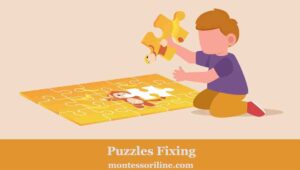
- What it is: Maps and puzzle pieces representing continents and countries.
- How it helps: Children learn about different parts of the world by putting together these puzzles. It’s like creating your own map of the world.
These materials make learning fun and hands-on, allowing children to explore and discover concepts at their own pace. They’re like special toys that help kids understand the world around them.
Benefits of Montessori materials
Hands-On Learning
- Benefit: Montessori materials are designed for tactile exploration, allowing children to physically interact with the materials. This hands-on approach enhances understanding and reinforces concepts through sensory experiences.
Concrete Understanding
- Benefit: The materials are tangible and concrete, providing children with a physical representation of abstract concepts. This aids in the development of a deep and lasting understanding of various subjects, from math to language.
Independence and Self-Discipline
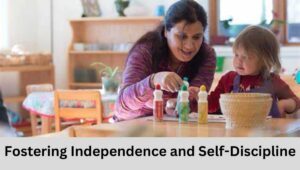
- Benefit: Montessori materials are often self-correcting, allowing children to identify and correct their own errors. This fosters a sense of independence and self-discipline as children take responsibility for their learning.
Sequential and Gradual Learning
- Benefit: The materials are structured in a sequential and gradual manner, introducing concepts from simple to complex. This gradual progression supports the natural development of a child’s skills and knowledge.
Individualized Learning
- Benefit: Montessori materials allow children to choose activities based on their interests and readiness. This individualized approach recognizes and accommodates each child’s unique learning pace and style.
Promotion of Critical Thinking

- Benefit: Many Montessori materials are designed to have a control of error, enabling children to recognize and correct mistakes on their own. This promotes critical thinking skills and the ability to learn from one’s experiences.
Development of Fine and Gross Motor Skills
- Benefit: Practical life materials, such as pouring or dressing frames, contribute to the development of fine and gross motor skills. These activities help children refine their movements and coordination.
Preparation for Future Academic Success

- Benefit: Montessori materials lay a solid foundation for academic subjects like math, language, and science. The hands-on, experiential learning approach fosters a love for learning and prepares children for future academic challenges.
Cognitive and Sensory Development
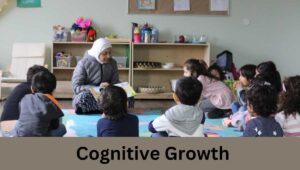
- Benefit: Engaging with the materials stimulates cognitive development by challenging the mind. Additionally, the sensory-rich nature of the materials enhances sensory perception and discrimination.
Promotion of Order and Concentration
- Benefit: Montessori materials are carefully organized and presented in a structured environment. This promotes a sense of order and encourages children to concentrate on their chosen activities for extended periods, supporting the development of focused attention.
Social and Emotional Growth
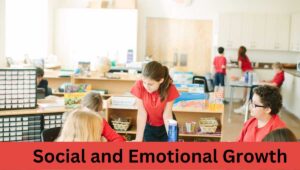
- Benefit: Collaborative use of materials in a Montessori setting encourages social interactions and cooperation. Moreover, the emphasis on independence and self-correction contributes to emotional resilience and self-esteem.
Preparation for Real-Life Skills
- Benefit: Practical life materials, such as pouring and dressing frames, prepare children for everyday tasks. These activities help build essential life skills that contribute to their overall independence and confidence.
Montessori materials play a crucial role in creating a learning environment that nurtures independence, critical thinking, and a love for learning. They are carefully designed tools that support a child’s holistic development, laying the foundation for a successful and fulfilling educational journey.
